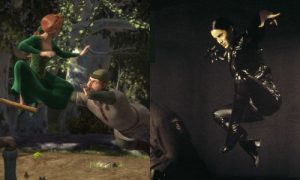While postmodernism has taken over our media in a noticeably different form than modernism, it often does so by reusing artifacts from the modernism time. Authors, film directors, and video game creators often quote or make references to well-known existing modern media. These references are made to make the media appealing to a wide range of people, as well as to demonstrate the popular postmodern style. In their article Practices of Looking: An Introduction to Visual Culture, Marita Sturken and Lisa Cartwright argue that “In postmodernism, the sense that everything has been done before gives way to relentless quoting and remakes, a context in which the only way to get noticed is to be ironic, to quote-not only words but also clothing and appearance styles.” We live in a time where it is hard to be original, because so much has already been created. As a result, trends in media and fashion reflect historical trends. This is the primary source of distancing irony in postmodernism. We are trying to be new by using the old, which would not be expected in any other circumstance.
Despite this irony being a prevalent element of postmodernism, we often do not even notice it. One explanation for this is that the references go over our head. For example, the reference to The Matrix in the movie Shrek (pictured below) was intended to appeal to an older audience (the children’s parents), but might be too mature to be understood by Shrek’s main audience (children). This is an interesting concept that was derived in postmodernism. Previously, a children’s movie would only be focused on entertaining children.

The creators of Shrek wanted to make their film enjoyable to the most amount of people. Another explanation us not noticing is that references like these are so common, they blend in with the media. Playing off scenarios from old media has become so standard in our postmodern idea of humor that they are almost expected. The “non-noticing” phenomenon adds to the irony of postmodernism. It’s ironic that references are put in children’s movies that they aren’t intended to understand, and that postmodern comedy relies on new jokes about old media.
The irony that arose in postmodernism makes me wonder what the next phase will be. What is after postmodernism? Post-postmodernism? I wonder how comedy will be created in this system. In a way, postmodernism was the hipster of the era. It took what was old and made it ironically cool again. Will the new era ironically quote the media of the postmodern era? I think this will be unenjoyable and boring. Media creators in future times will be presented with the same problem creators face now (that everything has been done), but will lack the option to reference it ironically because even that’s been done. Virtual reality and other technology are pushing society towards a new more involved and more immersive visual media experience. These advancements might make the postmodern irony almost obsolete. Interacting with media will feel so much like real life, you won’t notice any ironic discrepancies.